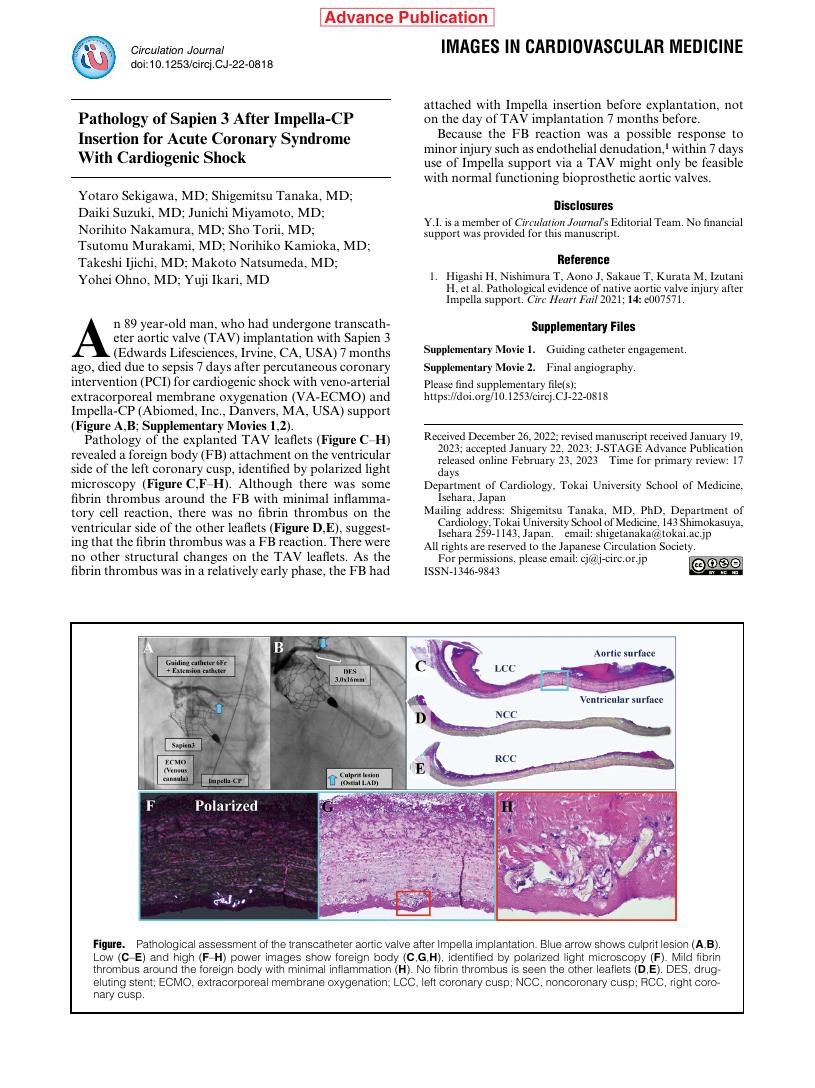7 0 0 0 OA Pathology of Sapien 3 After Impella-CP Insertion for Acute Coronary Syndrome With Cardiogenic Shock
- 著者
- Yotaro Sekigawa Shigemitsu Tanaka Daiki Suzuki Junichi Miyamoto Norihito Nakamura Sho Torii Tsutomu Murakami Norihiko Kamioka Takeshi Ijichi Makoto Natsumeda Yohei Ohno Yuji Ikari
- 出版者
- The Japanese Circulation Society
- 雑誌
- Circulation Journal (ISSN:13469843)
- 巻号頁・発行日
- vol.87, no.5, pp.672, 2023-04-25 (Released:2023-04-25)
- 参考文献数
- 1
2 0 0 0 OA Pathology of Sapien 3 After Impella-CP Insertion for Acute Coronary Syndrome With Cardiogenic Shock
- 著者
- Yotaro Sekigawa Shigemitsu Tanaka Daiki Suzuki Junichi Miyamoto Norihito Nakamura Sho Torii Tsutomu Murakami Norihiko Kamioka Takeshi Ijichi Makoto Natsumeda Yohei Ohno Yuji Ikari
- 出版者
- The Japanese Circulation Society
- 雑誌
- Circulation Journal (ISSN:13469843)
- 巻号頁・発行日
- pp.CJ-22-0818, (Released:2023-02-23)
- 参考文献数
- 1
- 著者
- Makoto Natsumeda Gaku Nakazawa Tsutomu Murakami Sho Torii Takeshi Ijichi Yohei Ohno Naoki Masuda Norihiko Shinozaki Nobuhiko Ogata Fuminobu Yoshimachi Yuji Ikari
- 出版者
- The Japanese Circulation Society
- 雑誌
- Circulation Journal (ISSN:13469843)
- 巻号頁・発行日
- vol.79, no.4, pp.802-807, 2015-03-25 (Released:2015-03-25)
- 参考文献数
- 28
- 被引用文献数
- 18 20
Background:Percutaneous coronary intervention (PCI) guided with fractional flow reserve (FFR) has been shown to improve clinical outcome. Although coronary angiography is the standard method for PCI guidance, the visual severity of stenosis is not always correlated with functional severity, suggesting that there are additional angiographic factors that affect functional ischemia.Methods and Results:To evaluate angiographic predictors of positive FFR in stenotic lesions, angiographic characteristics of 260 consecutive patients (362 lesions) who underwent FFR testing from April 2009 to September 2012 were analyzed. A scoring system (STABLED score) using these predictors was developed and compared with quantitative coronary angiography (QCA). %Diameter stenosis >50% (OR, 8.43; P<0.0001), tandem lesion (OR, 4.00; P<0.0001), true bifurcation (OR, 2.42; P=0.028), lesion length >20 mm (OR, 5.40; P=0.0002), and distance from ostium <20 mm (OR, 1.94; P=0.028) were determined as independent predictors of positive FFR. Area under the ROC curve for probability of positive FFR using the STABLED score (Stenosis 2 points, TAndem lesion 1 point, Bifurcation 1 point, LEsion length 1 point, Distance from ostium 1 point) was 0.85, higher than that for QCA stenosis alone (0.76). STABLED score ≥3 had 72.3% sensitivity and 83.6% specificity for predicting positive FFR, and PPV was 76.7%.Conclusions:Specific angiographic features are applicable for predicting functional ischemia. STABLED score correlates well with FFR. (Circ J 2015; 79: 802–807)
